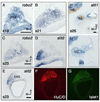Slits and Robos in the developing chicken inner ear
- PMID: 18213576
- PMCID: PMC2848755
- DOI: 10.1002/dvdy.21429
Slits and Robos in the developing chicken inner ear
Abstract
Mechanosensory hair cells in the chick inner ear synapse onto afferent neurons of the statoacoustic ganglion (SAG). During development, these neurons extend a central process to the brain and a peripheral process into one of eight sensory organs. A combination of cues, including chemoattractants and chemorepellents, direct otic axons to their peripheral targets. As a first step in evaluating the role of known axon guidance molecules, Slits and Robos, we examined expression of their transcripts in the chick inner ear from embryonic day 2-11 (Hamburger and Hamilton stages 14-37). Robo2 and slit2 are in migrating neuroblasts and the SAG, while both slits and robos are in the otic epithelium. We speculate that this family of signaling molecules may be involved in repulsion, first of otic neuroblasts and then of otic axons. Later our expression data revealed a potentially novel role for these molecules in maintaining sensory/nonsensory boundaries.
Figures



References
-
- Bashaw GJ, Goodman CS. Chimeric axon guidance receptors: the cytoplasmic domains of slit and netrin receptors specify attraction versus repulsion. Cell. 1999;97:917–926. - PubMed
-
- Bissonnette JP, Fekete DM. Standard atlas of the gross anatomy of the developing inner ear of the chicken. J Comp Neurol. 1996;368:620–630. - PubMed
-
- Bovolenta P. Morphogen signaling at the vertebrate growth cone: a few cases or a general strategy? J Neurobiol. 2005;64:405–416. - PubMed
-
- Brigande JV, Iten LE, Fekete DM. A fate map of chick otic cup closure reveals lineage boundaries in the dorsal otocyst. Dev Biol. 2000;227:256–270. - PubMed
-
- Brose K, Bland KS, Wang KH, Arnott D, Henzel W, Goodman CS, Tessier-Lavigne M, Kidd T. Slit proteins bind Robo receptors and have an evolutionarily conserved role in repulsive axon guidance. Cell. 1999;96:795–806. - PubMed
Publication types
MeSH terms
Substances
Grants and funding
LinkOut - more resources
Full Text Sources
Research Materials

